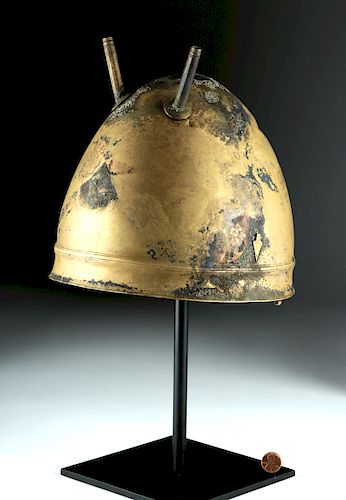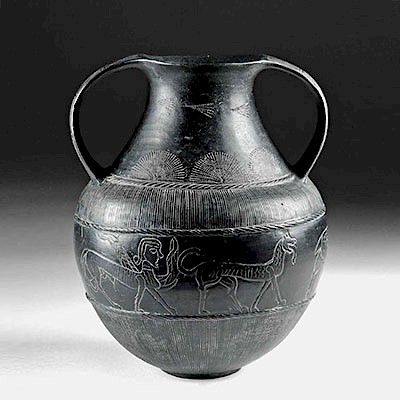Italic Bronze Helmet w/ River Patina - Negau Type
Lot 32a
About Seller
Artemis Fine Arts
686 S Taylor Ave, Ste 106
Louisville, CO 80027
United States
Selling antiquities, ancient and ethnographic art online since 1993, Artemis Gallery specializes in Classical Antiquities (Egyptian, Greek, Roman, Near Eastern), Asian, Pre-Columbian, African / Tribal / Oceanographic art. Our extensive inventory includes pottery, stone, metal, wood, glass and textil...Read more
Estimate:
$36,000 - $50,000
Absentee vs Live bid
Two ways to bid:
- Leave a max absentee bid and the platform will bid on your behalf up to your maximum bid during the live auction.
- Bid live during the auction and your bids will be submitted real-time to the auctioneer.
Bid Increments
| Price | Bid Increment |
|---|---|
| $0 | $25 |
| $300 | $50 |
| $1,000 | $100 |
| $2,000 | $250 |
| $5,000 | $500 |
| $10,000 | $1,000 |
| $20,000 | $2,500 |
| $50,000 | $5,000 |
| $100,000 | $10,000 |
| $200,000 | $20,000 |
About Auction
By Artemis Fine Arts
Mar 21, 2019
Set Reminder
2019-03-21 10:00:00
2019-03-21 10:00:00
America/New_York
Bidsquare
Bidsquare : Fine Ancient | Asian | Ethnographic Art
https://www.bidsquare.com/auctions/artemis-gallery/fine-ancient-asian-ethnographic-art-3967
Featuring classical antiquities, ancient and ethnographic art from cultures encompassing the globe, plus fine art. Egyptian, Greek, Roman, Etruscan, Near Eastern, Asian, Pre-Columbian, Native American, African / Tribal, Oceanic, Spanish Colonial, Russian, Fine Art, so much more! Artemis Fine Arts info@artemisgallery.com
Featuring classical antiquities, ancient and ethnographic art from cultures encompassing the globe, plus fine art. Egyptian, Greek, Roman, Etruscan, Near Eastern, Asian, Pre-Columbian, Native American, African / Tribal, Oceanic, Spanish Colonial, Russian, Fine Art, so much more! Artemis Fine Arts info@artemisgallery.com
- Lot Description
Italic, late Archaic or Classical, ca. 500 to 400 BCE. A bronze helmet with twin attachments for feathers - a variant of the Negau type, a regional Italian style with a characteristically conical shape. The capped form (without the typical pronounced rib) resolves in a concave neck that does not have a brim. A slender molded band sits where cap and neck meet as well as a small groove incised at the lower edge of the neck. Two loops with heart-shaped attachment plates are positioned just off center on the neck band's interior surface, and two additional loops with triangular attachment plates are on the exterior of the cap, about two inches from the inner loops - perhaps intended to attach cheek pieces. Two fluted tubes with molded termini are attached to the front of the helmet, near the crown, and tilt slightly back. These likely held feathers. Below and between them are the remains of another shield-shaped attachment. Outstanding and covered with golden river patina! Size: 8.875" L x 8.25" W x 7.375" H (22.5 cm x 21 cm x 18.7 cm); feather tubes 2.125" L (5.4 cm)
This helmet has been identified as a Negau type (also known as the Vetulonic type) helmet, named for the village in Slovenia where such helmets were initially found. Why have ancient helmets been found in rivers? Some have attributed this phenomenon to accidental losses; however, according to recent scholarship, discoveries of ancient armor in aquatic environments may be the result of intentional practices. Some have suggested that the ancients' veneration of water played a significant role, that gear found in waters was the consequence of a conscious religious act, a dedication of armor and weapons as a religious rite. Others have argued that when ancient warriors who were forced into retreat came upon a river, they elected to toss their armor in the waters, since it would be next to impossible to cross a river wearing such heavy gear. Depositing the armor on the enemy's land was not viewed upon as an attractive option, because the warriors feared that their foes would either use the armor to impersonate them during ensuing battles or melt the armor down for the valuable precious metals. For further discussions, see Brandon Olson's "The Dedication of Roman Weapons and Armor in Water as a Religious Ritual" Popular Archaeology (May 27, 2011).
Cf. a pilos helmet in Berlin, illustrated in Antikenmuseum Berlin (Berlin, 1988), no. 1 on pp. 80-81. For drawings of helmets with feather decoration, see John Warry, "Warfare in the Classical World" (Dallas, 2001), pp. 103 & 109; for a discussion of the Negau helmet type, see "Antike Helme" (Mainz, 1988), pp. 243-270.
See another Negau type helmet in the Museum of Fine Arts Boston - https://www.mfa.org/collections/object/helmet-of-negau-type-153366
Provenance: private East Coast, USA collection; ex-Richard Wagner collection, Cape Cod, Massachusetts, USA, acquired in the 1960s
All items legal to buy/sell under U.S. Statute covering cultural patrimony Code 2600, CHAPTER 14, and are guaranteed to be as described or your money back.
A Certificate of Authenticity will accompany all winning bids.
We ship worldwide and handle all shipping in-house for your convenience.
#139400Feather tubes have been reattached. Dent to back of helmet. Expected wear commensurate with age. Areas of encrustation. Gorgeous golden river patina.Condition
- Shipping Info
-
All shipping is handled in-house for your convenience. Your invoice from Artemis Gallery will include shipping calculation instructions. If in doubt, please inquire BEFORE bidding for estimated shipping costs for individual items.
-
- Buyer's Premium



 EUR
EUR CAD
CAD AUD
AUD GBP
GBP MXN
MXN HKD
HKD CNY
CNY MYR
MYR SEK
SEK SGD
SGD CHF
CHF THB
THB














